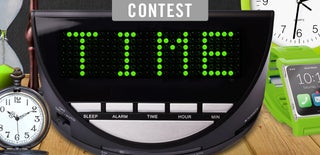Introduction: 3:30 Clock
I wanted to make a wall clock that emphasizes when its 3:30.
Why 3:30? Because most days, at 3:30 PM I need to leave whatever I’m doing and go pick up my kids from kindergarten and daycare. Sometimes I’m so engrossed in what I’m doing that I’m surprised to see that I’m about to be late.
Step 1: Use Cardboard to Create a Full-size Model of the Clock
The main design is a circle base with 2 circles at the 3:30 hours and minutes position.
Since 3:30 is specific to my needs, you may want to emphasize a different time.
I suggest to put it up of the wall where it is going to be to see how it looks and how it works with the room.
I wanted mine to be minimalistic on one hand but also to stand out so I decided on a pretty big base (45 cm diameter). The diameters of the 3:30 circles are 3 cm.
In addition, the hands are 2 isosceles triangles with cut out circles that align with the 3:30 indicator circles.
I wanted to put a positive twist on the 3:30 time constraint. This way 3:30 actually creates ‘perfect’ triangles.
In the actual end result I designed the hands a bit different. I'm not sure if the original triangles weren't a better design.
In addition, I have 11 small circles (1 cm diameter) to mark the hours.
I suggest to add the clock mechanism to the model to see if any adjustments are required.
Step 2: Vector File for Laser Cutting
You can use many different materials for the clock. The easiest would probably be plywood that you can cut using a jigsaw at home.
I wanted to use 3 mm plexiglass cut using laser cutting.
For laser cutting you need a vector file. Vector files can be created in programs such as Adobe Illustrator, Corel Draw, Autocad, etc…
I’m using Solidworks, you can find the original file and the DWF file below.
I went to the laser cutting shop to select the specific color for mine.
Regarding the hands, their center of gravity must be close to the center of the clock (where they fit onto the mechanism) otherwise they may touch each other and stop the clock from running. Therefore for long hands you need to add a 'tail' that balances them out. I learned this the hard way....
Step 3: Assembly
If you make a smaller clock you can just buy a simple clock mechanism at any hobby or arts&crafts store. Since the hands are relevantly long and heavy in mine I needed a stronger mechanism. You just need to ask at the store.
For the 3:30 hour and minute marks I used a 3.2 cm diameter round plate I got in an arts and crafts shop in the jewelry section.
I soldered a rounded aluminium strip to it to fit into the holes in the base.
I keep the protective film on the plexiglass until I was finished with the whole project to avoid scratches.
In the plexiglass hands I made the hole where they fit on the clock mechanism shaft a bit bigger and glued in the circles that are used in standard hands. This way I was sure they'd fit on the clock shaft exactly.
Step 4: Electronics (optional)
Although the design already emphasizes the 3:30 time mark, I wanted to add Led lights below the 3:30 hour and mins circles that would light up from around 3:15 until 3:35 (how cool is that ? :))
I thought about how to time the lights for quite a while. Even went to the extreme of arduino and stepper motors until I saw this tutorial Sonic Tripwire Alarm and realized I could just leave the circuit open, put something conductive beneath the hour hand so that from 3:15 until 3:35 the circuit with close.
The hour hand is beneath the minute hand so that worked out ok.
For the lighting I choose 2 blue Leds each with their own 3V coin battery. They are not connected in any way to the clock mechanism.
There are 4 tiny 1 mm holes through which I threaded the electric wires. On the back of the hour hand I glued some aluminum I cut and rolled from an aluminum tin pan.
Step 5: Summary
So in this first version, the electric circuit is very delicate. The metal beneath the hour hand needs to be just right so that on the one hand it closes the circuit and on the other hand doesn’t get the hour hand stuck.
I’m now waiting on some light sensors and arduino I ordered. The plan is to use 2 light sensors - 1 to determine if it day time and the second to be triggered when the hour hand covers it and then base the lights on those triggers. I hope this will be a more elegant solution.
I also want to add a buzzer to beep from 3:15 til 3:30 at decreasing intervals.
Version 2 is out there!
Feel free to post in the comments.

Runner Up in the
Time Contest














